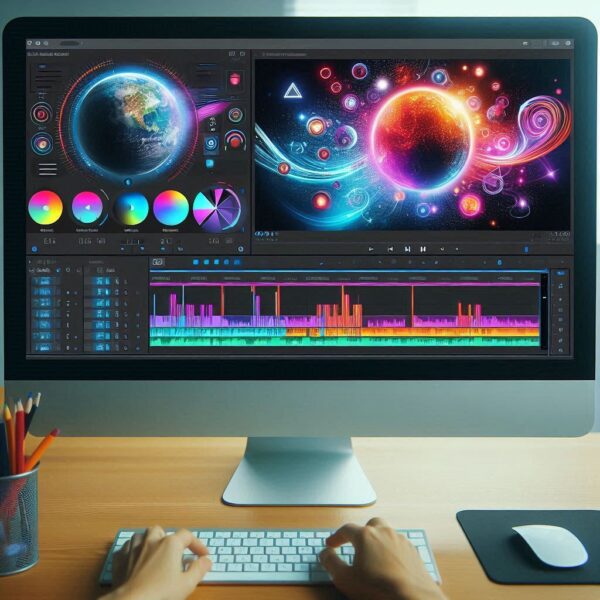In today’s digital world, creating professional-looking videos is more accessible than ever, thanks to the availability of top-notch video editing software. Whether you’re a professional videographer, a social media content creator, or someone who enjoys making videos for fun, choosing the right editing tool can significantly improve your content. With so many options available, it can be challenging to decide which software best suits your needs.
This blog will explore the top 7 video editing software that caters to a range of skill levels and preferences. Each software package brings its unique features, strengths, and benefits to the table, making it suitable for different types of users. Let’s dive into the details.
1. Adobe Premiere Pro
Adobe Premiere Pro is widely recognized as one of the leading video editing software for professionals. It’s part of Adobe’s Creative Cloud, allowing seamless integration with other Adobe products like After Effects, Photoshop, and Illustrator. This video editing software has been a favorite for video editors in the film and television industry due to its powerful features and flexible interface.
Key Features:
- Multicam Editing: Premiere Pro supports multi-camera editing, making it ideal for projects with different camera angles.
- Advanced Color Grading: The Lumetri Color panel allows for professional-level color grading and correction.
- Audio Editing Tools: The software offers tools for editing audio, including audio track mixing, automatic ducking, and audio effects.
- Supports Various File Formats: Premiere Pro can handle a wide range of file formats, from 8K video footage to lower-resolution content.
- Integration with Adobe Products: The software integrates smoothly with After Effects for motion graphics, and Audition for audio editing.
Pros:
- Professional-grade editing capabilities.
- Regular updates and new features.
- Supports a wide range of video formats.
Cons:
- Subscription-based models can be costly.
- Can have a steep learning curve for beginners.
Best For: Professional video editors, filmmakers, and content creators who require a robust tool for complex projects.
2. Final Cut Pro X

For macOS users, Final Cut Pro X is often the go-to choice for video editing. Developed by Apple, it’s known for its smooth performance on Mac computers and offers a balance between professional features and user-friendly design. It’s popular in the film industry and is suitable for various types of video projects, from short YouTube videos to full-length feature films.
Key Features:
- Magnetic Timeline: This innovative editing feature allows for flexible and non-linear editing without clip collisions or sync problems.
- 360° Video Editing: Supports 360-degree VR video editing, making it an excellent choice for immersive content creation.
- Multicam Editing: Offers support for editing projects with multiple camera angles.
- Color Correction and Grading: Comes with advanced tools for color correction, including HDR support.
- Optimized for Mac: Final Cut Pro X takes full advantage of Mac hardware, offering smooth playback and rendering.
Pros:
- One-time purchase instead of a subscription.
- Fast and efficient performance on Mac.
- User-friendly interface.
Cons:
- Only available on macOS.
- May not integrate well with non-Apple software.
Best For: Mac users, professional video editors, and YouTubers who want a powerful yet accessible editing tool.
3. DaVinci Resolve
DaVinci Resolve is renowned for its powerful colour grading capabilities and has gained popularity among professional editors and filmmakers. It offers a free version with a wide range of features, making it a popular choice for beginners and budget-conscious editors who still want professional-level tools.
Key Features:
- Color Grading Excellence: The color correction and grading tools are considered some of the best in the industry.
- Fusion VFX Integration: Comes with an integrated visual effects suite for motion graphics and compositing.
- Fairlight Audio: DaVinci Resolve includes advanced audio editing capabilities.
- Collaboration Tools: Allows multiple users to work on the same project simultaneously, which is ideal for team projects.
- Non-Linear Editing: The timeline-based editing offers flexibility for complex projects.
Pros:
- The free version includes a significant number of features.
- Powerful color correction and grading tools.
- Suitable for both amateurs and professionals.
Cons:
- The interface can be overwhelming for beginners.
- Requires a powerful computer for smooth operation.
Best For: Professional colorists, filmmakers, and editors looking for a feature-rich and free editing solution.
4. iMovie

iMovie is a free video editing software designed for macOS and iOS users. It’s an excellent choice for beginners due to its simple interface and basic editing tools. While it doesn’t offer the advanced features found in professional-grade software, it is perfect for casual video projects and personal use.
Key Features:
- Drag-and-Drop Interface: The user-friendly interface makes it easy to import, edit, and organize clips.
- Themes and Templates: Comes with built-in themes and templates for creating professional-looking videos with minimal effort.
- Basic Color Correction and Effects: Offers essential tools for color correction, transitions, and effects.
- 4K Video Support: Allows for editing 4K resolution videos.
- Seamless Integration with Apple Devices: Projects can be easily transferred between iPhone, iPad, and Mac.
Pros:
- Free for macOS and iOS users.
- Easy to learn and use for beginners.
- Great for quick video projects.
Cons:
- Lacks advanced editing features.
- Only available for Apple users.
Best For: Beginners, casual video editors, and macOS users looking for free software for basic video projects.
5. HitFilm Express
HitFilm Express is a free video editing and VFX software that provides a combination of basic and advanced features. It’s ideal for users who want to create visually engaging content, such as YouTube videos or short films, without spending a lot on software.
Key Features:
- Visual Effects Capabilities: Offers a wide range of VFX tools for creating explosions, lightsabers, and other visual effects.
- Layer-Based Compositing: Allows for advanced compositing similar to Adobe After Effects.
- Audio Tools: Includes audio editing tools and effects.
- 3D Model Importing: Supports importing 3D models for incorporating into videos.
- Extensive Tutorials: The developers offer plenty of tutorials to help users learn the software.
Pros:
- Free with optional paid add-ons.
- Good balance of video editing and visual effects.
- Suitable for indie filmmakers and YouTube creators.
Cons:
- Requires a higher-end computer for smooth performance.
- Some features require purchasing add-ons.
Best For: YouTubers, indie filmmakers, and users who want to add visual effects to their videos.
6. CyberLink PowerDirector
CyberLink PowerDirector is known for being a feature-rich and user-friendly video editing software. It caters to both novice and intermediate users and provides a range of effects, transitions, and templates to create professional-quality videos quickly.
Key Features:
- MultiCam Editing: Supports editing videos from multiple camera sources.
- 360-Degree Video Editing: Includes tools for creating and editing 360° videos.
- AI-Powered Tools: Features AI tools for color correction, sky replacement, and background removal.
- Drag-and-Drop Interface: Simplifies the editing process for users.
- Fast Rendering: PowerDirector is known for its efficient rendering speeds.
Pros:
- Beginner-friendly with professional features.
- Regularly updated with new features.
- Affordable pricing for the premium version.
Cons:
- The interface may be too simplified for advanced users.
- Some effects may require additional purchases.
Best For: Beginner and intermediate users who want a balance between ease of use and professional features.
7. Filmora
Filmora is a popular choice among YouTube creators and vloggers due to its simplicity and extensive library of effects, transitions, and royalty-free music. It is suitable for users who want to create eye-catching videos quickly without a steep learning curve.
Key Features:
- Drag-and-Drop Interface: The user-friendly interface allows for easy video editing.
- Effects Library: Offers a large library of effects, filters, and transitions.
- Audio Editing Tools: Includes tools for audio mixing and noise removal.
- 4K Video Support: Allows users to edit videos in 4K resolution.
- Screen Recording: Comes with built-in screen recording capabilities, ideal for tutorial creators.
Pros:
- Affordable and user-friendly.
- Ideal for social media content creators.
- Frequent updates with new effects and features.
Cons:
- Lacks some advanced features found in professional software.
- Watermarks in the free version.
Best For: YouTubers, vloggers, and beginners who want to create visually engaging content.
Conclusion
Choosing the right video editing software depends on your specific needs, skill level, and budget. Here’s a quick summary to help you decide:
- Adobe Premiere Pro is the industry standard for professionals looking for a comprehensive editing tool.
- Final Cut Pro X is the best choice for macOS users who want a blend of professional features and ease of use.
- DaVinci Resolve stands out for its color grading capabilities and is a great free option for those seeking professional tools.
- iMovie is perfect for beginners and Apple enthusiasts who need a simple, free editing tool.
- HitFilm Express caters to indie filmmakers and YouTubers who need basic VFX capabilities.
- CyberLink PowerDirector is ideal for beginner to intermediate users looking for affordable yet professional editing software.
- Filmora is suitable for social media content creators who prioritize simplicity and quick editing.
With these top 7 video editing software
